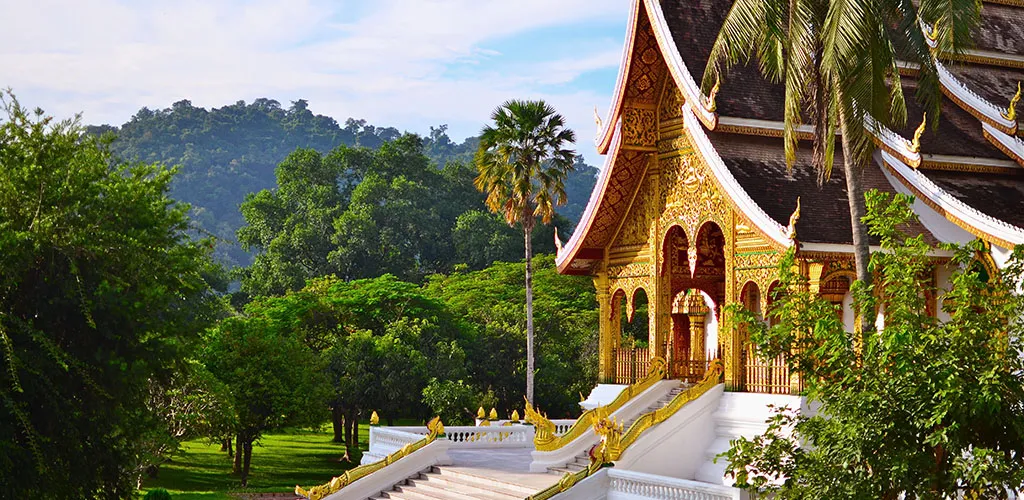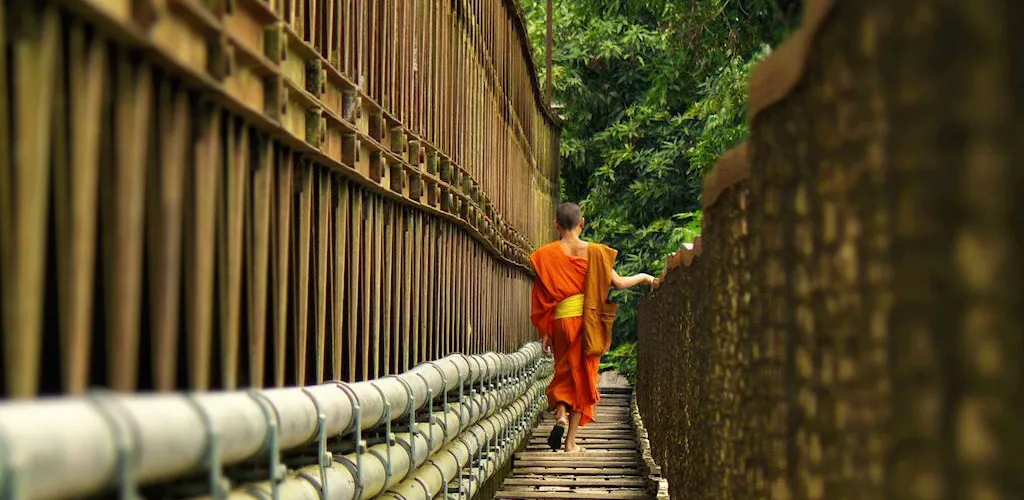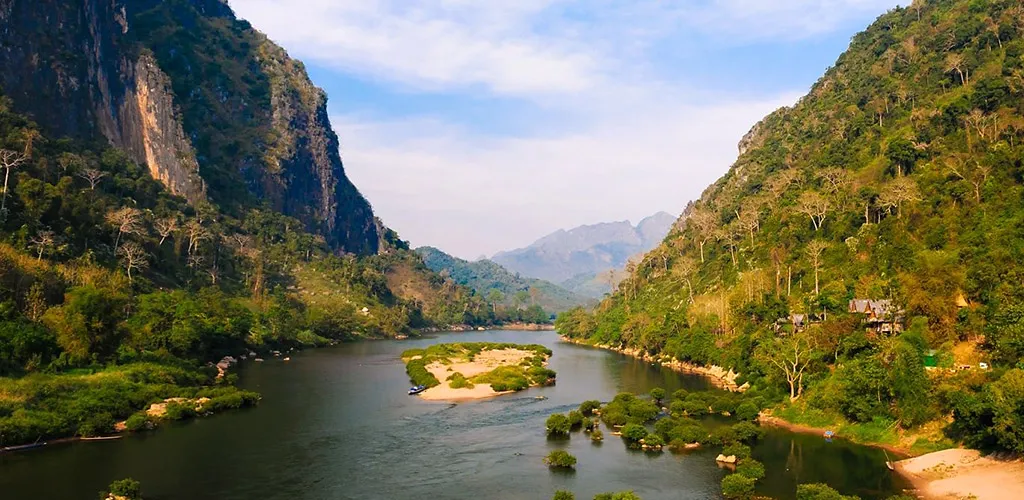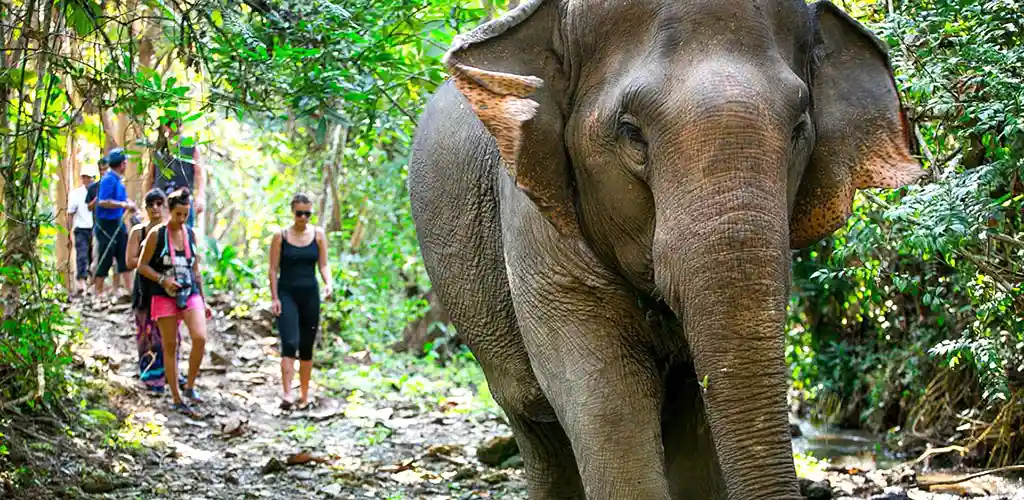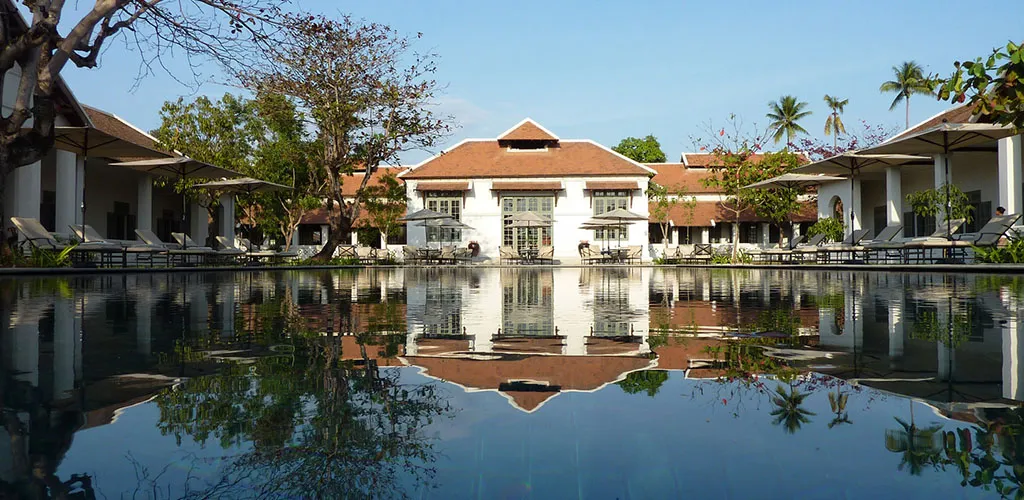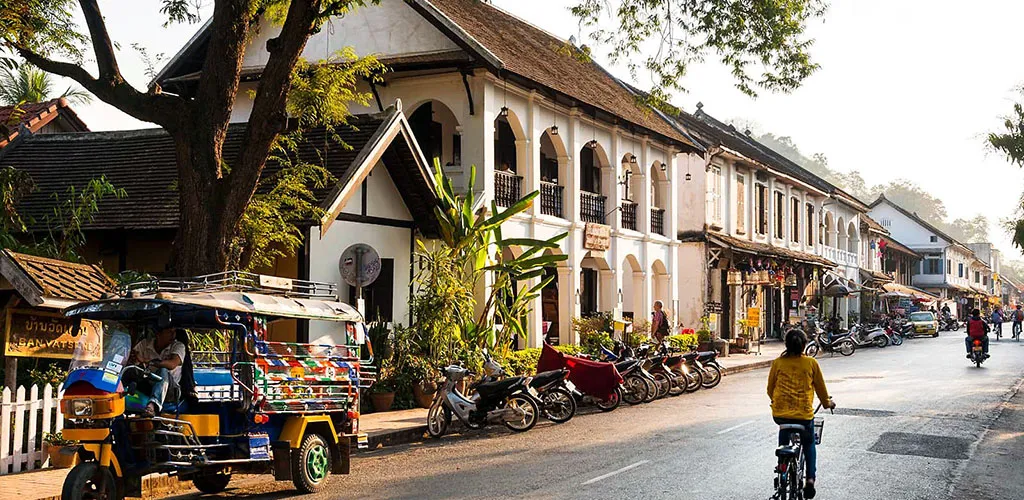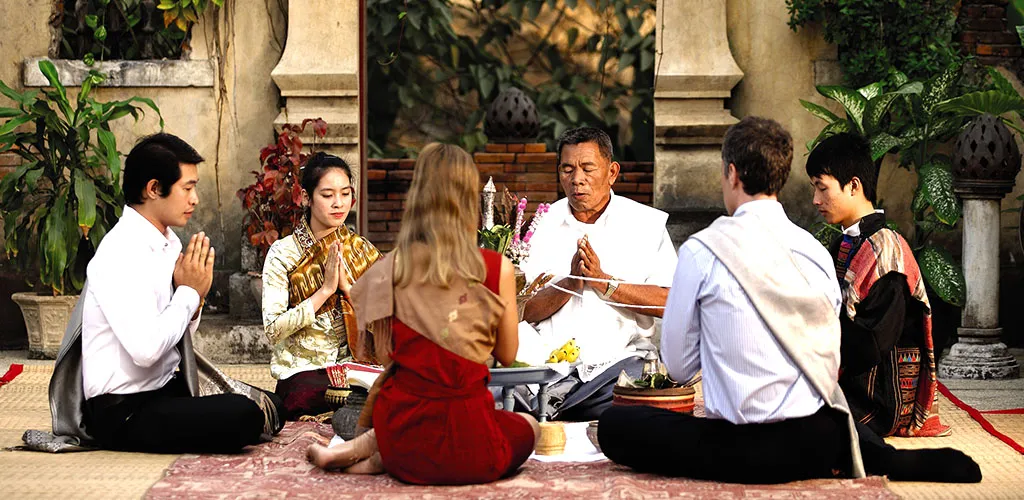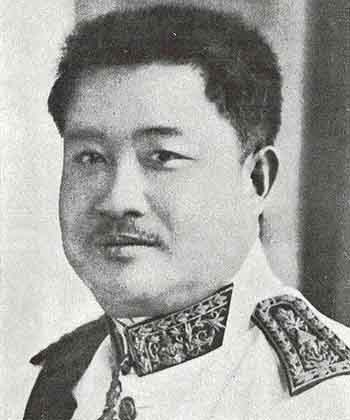The Many Splendors of Luang Prabang
Luang Prabang, a little city of 80,000 or so people, neither teems with excitement nor seethes with intrigue. Life flows slowly here, like the muddy Mekong. The people are gentle and unassuming. Two lazy rivers happen upon each other in their wanderings through Luang Prabang — the Nam Khan and the swirling brown Mekong. The landscapes of northern Laos are impossibly beautiful and tranquil and it is in sublime Luang Prabang, surrounded by flame trees and a profusion of tropical palms, one discovers lost Shangri-La.
The splendid old capital features a cluster of shimmering royal temples, palace, and administrative buildings, remnants of the faded grandeur of the Lao monarchy. Small and compact, the town is encircled by peaks and camouflaged by palm trees and dense tropical foliage. From a distance, only golden-spired stupas can be seen, flashes of gold among the greenery. The serene town remains one of the most well-preserved in Asia bypassed in the rapid development that has seized the rest of the region. Delicious cuisine, authentic markets, and gentle residents round out one of Asia's most remarkable, and for now, last secret place.
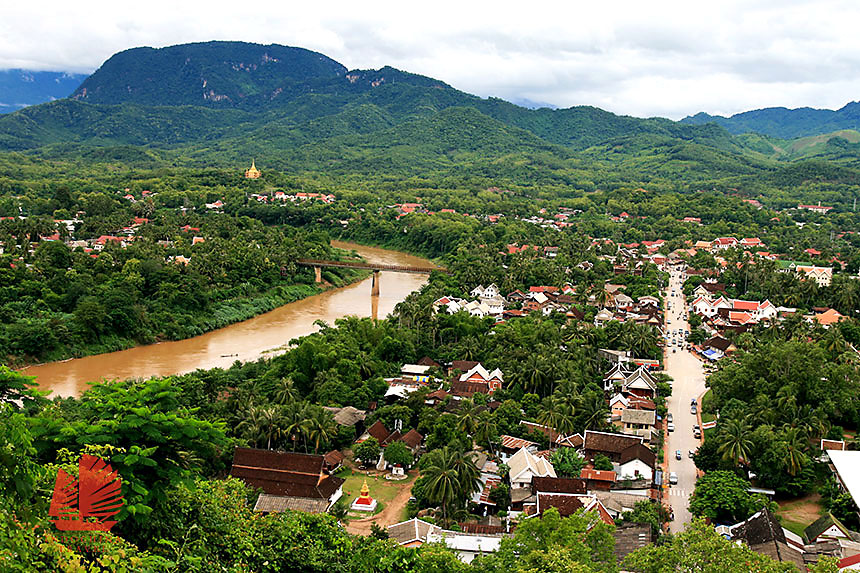
Luang Prabang is the splendid ancient capital of Laos, situated in the remote north, featuring a cluster of shimmering royal temples and well-preserved French architecture—remnants of the faded grandeur of the Lao monarchy and colonial era that followed. Luang Prabang is tiny and compact with a bucolic setting on a tongue of land at a strategic junction of the Mekong and Khan Rivers encircled by peaks and camouflaged by palm trees and dense tropical foliage... from a distance, only golden-spired stupas can be seen—flashes of gold rising above the greenery. Situated a day's drive from the modern Lao capital Vientiane or 90-minutes by air from Bangkok, Luang Prabang's temples, its gilded reliefs and cool promenades provide travellers with the ultimate retreat from the pressures of the modern world. In the shadow of perfumed forests, you can literally soothe your senses, lulled by the tinkling of bells and the chanting of monks.
Through the scratched window he could see the sun reflecting golden from half a dozen temple stupas, two rivers converging around the town, and a white shrine, like a delicious merangue, sitting on top of a hill overlooking the old royal palace." The Thirty Three Teeth by Colin Cotterill
Luang Prabang Highlights
- Discover a Northern Thailand of decades ago, before the traffic, tour groups, banks, and fast-food chains. UNESCO World Heritage status has kept the bulldozers at bay, at least for now. Thailand has changed dramitically over the last few decades, see Laos before it follows.
- Buddhism still reigns in Luang Prabang, a small town seemingly comprised of gilded temples and monasteries, where monks can be seen walking along every street and alley way.
- One of Asia's most beautiful towns with a tranquil location where the Mekong and Nam Khan rivers converge.
- Remote escapes. Stunning river valleys, hilltribe villages, and mountain scapes are comfortable day trips from Luang Prabang.
- Elephant sanctuaries—the finest in the world (see our Elephant Camp report)
- Night Market. Every evening the central road closes for an open-air market featuring handmade crafts
- Compliments Vietnam and Cambodia. Laos is the often bypassed third country of historic Indochina, with some resemblence to Vietnam and Cambodia, but little else, including it's languid culture.
Historic Luang Prabang
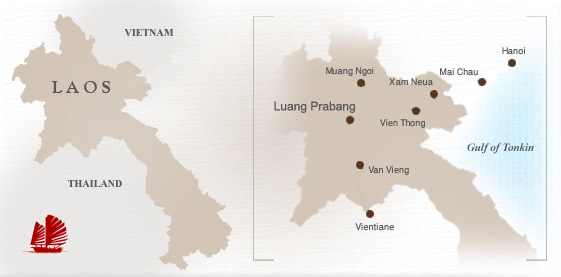 |
Benefited from rich fertile land and its proximity to Mekong River, the Luang Prabang people have enjoyed their simple way of lives which have been kept intact since the last century. Luang Prabang has long been the site of local kingdoms; in the 14th century, the first kingdom of Laos, Lan Xang, was established here by King Fa Ngum. The kingdom lasted two hundred years before the royal seat was transferred to Vientiane. When the kingdom of Lan Xang split up on the death of King Souligna Vongsa in 1694, Luang Prabang was one of three independent kingdoms created.
The city-state has seen its share of invasions; the place has been sacked and rebuilt, and many older wooden structures have disappeared without trace. Luang Prabang's natural beauty and its golden temples are well-preserved because of the town's isolation. Although it flourished as a trading post among the people of upper Laos, Thailand, Vietnam, southern China, and Myanmar (Burma), there was little contact with non-Asian countries until the French arrived in the mid-19th century. Under French rule, a commissariat was established in Luang Prabang, which led to a spate of French residential building. The Lao monarchy endured in Luang Prabang, surviving right up until 1975.
LAOS TRAVEL PRACTICALITIES Laos Visa Best time to visit Laos? Language Money Matters Health and Medical General Travel Tips Insider Tip Shopping : Galleries, Markets, Shops & More |
Most surprising about this jewel in northern Laos in an overcrowded region is that the present population of Luang Prabang is only about 50,000, with even less in the downtown area. One of Asia's least populated towns in one of the lowest densely populated countries in Asia (about 20 people per square kilometer in Laos, versus 230 in Vietnam) Luang Prabang works its charm on visitors: it has the aura of a place caught in a time warp, with orange-robed monks making their rounds, market and Mekong commerce, women cycling along with parasols to ward off the midday sun. The days of Luang Prabang's isolation, however, are numbered. Transport to the town has improved dramatically with a paved road snaking in from Vientiane, and plans for a larger airport. On the drawing board is a road linking Luang Prabang all the way to the Chinese border.
Preserving Luang Prabang
In December 1995, the entire town of Luang Prabang, including its Mekong shoreline, was inscribed on the UNESCO World Heritage Site List. The UNESCO report identified 33 temples and 111 historic Lao-French buildings for specific restoration, citing Luang Prabang as the best-preserved traditional town in Southeast Asia-a kind of outdoor museum. The UNESCO plan for Luang Prabang guarantees preservation of the town's heritage and limits new building developments. To preserve the town's character, zoning laws restrict advertising billboards and decree that no concrete eyesores or out-of-character buildings can be constructed (which means no plague of photo-finishing shops or fast-food outlets will be visited upon the place). Power and telephone lines must be buried.
Under World Heritage Site plans, Luang Prabang's temples are being painstakingly restored, with particular attention to artwork damaged by monsoon rains and tropical humidity. Temples were the center of the Lao universe and, until the French arrived, were the only structures allowed to be constructed of brick. The French led indolent lives in Luang Prabang, and it remained an idyllic trading backwater. In 1907 the French finally got into gear, with a spate of colonial building in Luang Prabang that lasted until 1925. The French administration used styles developed in Vietnam-but instead of simply transplanting European architecture, they adapted designs to better suit the climate: wooden houses with internal corridors to provide cool air circulation. There are temple-inspired designs and remarkable blends of Lao-French architecture. Not so inspiring are the French public buildings: the former customs house, post and telegraph office, school, hospital, and gendarmerie. To build these, the French imported Vietnamese laborers who established their own quarter at the south side of the peninsula, constructing two-story Chinese shop houses to live in.
There are three zones for preservation under the UNESCO plan: the Old Quarter (in the palace vicinity, along the peninsula), a peripheral building zone, and natural zones along the Mekong River banks. The Old Quarter is fully protected, with stringent building restrictions; in the peripheral zone, new building is permitted but must be "in character."
Paradoxically, designation as a World Heritage Site has lead to a substantial boost in tourism, which places a heavy demand on hotel resources. Here lies a riddle: how can Luang Prabang preserve its traditional character and yet expand its hotel offerings? The solution has been to convert existing colonial mansions for use as guest houses: in the Old Quarter, the number of guest rooms in new hotels is limited to fewer than 15. Beautifully restored colonial villas like Auberge Calao and Villa Santi stand out in fulfilling these guidelines; the Paphay Guesthouse preserves a traditional Lao timber house. Outside the fully protected zone, larger hotel construction has been permitted, subject to design approval. One eye-catching design is utilized at Mouang Luang Hotel, completed in 1996; this hotel draws its inspiration from Luang Prabang temples.
Limited photography and other details on the different styles of architecture can be found at Heritage House, itself a Lao heritage building. This place offers training and advice on restoration techniques and heritage protection for residents. Heritage House is signposted deep down an alley just east of the Palace Museum.
Festivals
Usually two to five days should suffice to see Luang Prabang, but if it's festival time, plan to stay longer. Because of its previous links with royalty, Luang Prabang festivals are elaborate, sometimes lasting a week or longer. The place is packed around festival times, especially at Pimai (Lao New Year) and for the annual boat racing in August. For Pimai, people from all over the province make a beeline for Luang Prabang for four days of fun and festivity. Pimai kicks off with the crowning of Miss New Year, who is paraded through town; the following days see the ceremonial washing of Buddha statues, construction of small sand stupas in wars as symbolic requests for prosperity in the coming year, processions of monks, a candlelit tour of Mount Phousi, baci ceremonies, folk singing and circle-dancing, fairgrounds, and fireworks. During the August boat races, temple longboats are raced by people living in the vicinity of each war.
LUANG PRABANG SIGHTS
To see Luang Prabang at its most magical, rise at dawn and wander down the narrow backstreets, where lines of monks on their daily alms round receive offerings of rice and fruit from the Buddhist faithful. Momentarily, the town is filled with languid, swaying figures clad in saffron robes. Then almost as suddenly as they have appeared, they stride off into the distance, returning to their Buddhist retreats in leafy compounds dotted around the city. Elsewhere on this sleepy peninsula, home to the Royal Palace and the revered Prabang Buddha image, history mingles with religion, providing a reminder of the days when this region was known as Lan Xang: Land of a Million Elephants and the White Parasol. The small town is one of those very few delightful places you can still cover on a bicycle or by foot. Oddly enough, there are no cyclos in Luang Prabang, only motorized tuk-tuks.
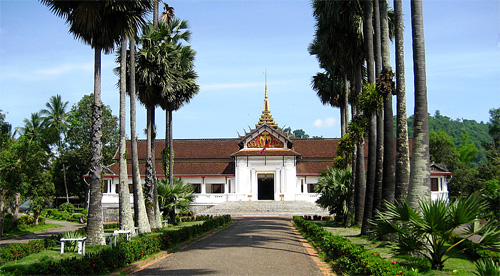
|
Old Quarter Heritage Buildings
The UNESCO World Heritage Site List cited Luang Prabang as a town not only of temples but also of Lao-French historic housing. Opposite War Mai, in the Ministry of Culture and Information building, is a small display of heritage housing. Under the French, the building was once the library, and, before that, the Gendarmerie, with construction dating from 1920 to 1925. This part of town is the former French administrative center; The Lane Xang Bank is a renovated French colonial building. On the same side of the street as the bank, and near it, is a single-story Vietnamese-style mansion dating from 1923 that is now home to several shops. If you proceed east along Thanon Phothisarat, you'll come across Chinese-style shop fronts, a few colonial mansions like Villa Santi (former homes of royalty and aristocracy), and an odd mix of French and Lao styles at War Khili.
Mount Phousi
To get your bearings on Luang Prabang, and get some exercise, trek to the top Mount Phousi at the heart of Luang Prabang. It's an excellent place at sunset and it's great for picnics. The wats here are small; it's the views you go for. You can approach or leave the peak from several directions via steep staircases. A round hike from the Khemkhane Garden Restaurant direction can be done as a side trip on a bike tour. Or start from the Khemkhane side, viewing Pra Puttabat, Tham Phousi, and That Chomsi, and emerge opposite the Palace Museum; from there you can walk east past War Sene to War Xieng Thong. Or, if you have a few hours, you can take a longer hike across the other side of the Mekong.
"The second sunrise comes about 8 A.M. It was when the first sun had risen high enough to reflect from the golden dome of Xiang Thom temple. For many in Luang Prabang, this marked the time to head for work—which, in turn, explained why so many people stayed in bed on cloudy days." Thirty-Three Teeth
Mount Phousi is a 150-meter-high rocky outcrop with forested slopes. In the 18th century it was covered with monasteries; several small monasteries continue to operate. Opposite the royal palace, on the lower slopes of Mount Phousi, is the abandoned temple of Wat Huak, with a carved wood facade and excellent interior murals depicting visits by foreign diplomats. The war is locked, but an attendant can be persuaded to open up on token payment. Winding up some 300 steps, at the summit of Mount Phousi is That Chomsi, a gold-spired stupas on a rectangular base constructed in 1804 and restored a century later. This is a prime viewpoint and the focus of a candlelit procession ' during Pimai in April. A Russian antiaircraft gun is positioned on a ridge up here. Down the hill is Tham Phousi, a rock shrine with a fat Buddha image in a cave.
A second fine viewpoint is located at Pra Puttabat, which features an enclosure containing a giant Buddha footprint. You must locate one of the monks nearby to open the sanctuary The original wooden temple on this site dates back to the 17th century, with the present structure erected in 1959. Back down at the base of Mount Phousi on the northeast side are two wars; one, Wat Paphane, has a classic carved and painted facade.
Palace Museum
The Palace Museum is a must stop. Although there's absolutely nothing sacred about the king anymore, the museum has a dress code for Lao and foreign visitors: no shorts, T-shirts, or short dresses and you must leave any cameras or bags at the front reception area.
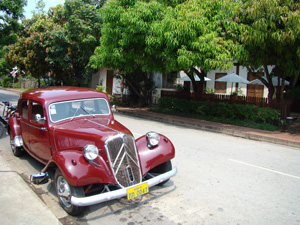 The Royal Palace was built 1904-1909, with later extensions and renovations. It's surrounded by a high fence and extensive gardens. Although occupied by Lao King Sisavang Vong, the building was commissioned by the French colonial administration, which explains the mix of French and Lao architecture. This effect was intentional, meant to cement the relationship. At the front entrance, high up on the front of the building, is Erawan, the three-headed elephant symbolizing the three kingdoms of Laos. The pillars below bear French fleur-de-lys emblems, and you sweep up steps made of Italian marble. Inside are French mirrors and Czech chandeliers alongside traditional Lao lacquered and gilded furniture.
The Royal Palace was built 1904-1909, with later extensions and renovations. It's surrounded by a high fence and extensive gardens. Although occupied by Lao King Sisavang Vong, the building was commissioned by the French colonial administration, which explains the mix of French and Lao architecture. This effect was intentional, meant to cement the relationship. At the front entrance, high up on the front of the building, is Erawan, the three-headed elephant symbolizing the three kingdoms of Laos. The pillars below bear French fleur-de-lys emblems, and you sweep up steps made of Italian marble. Inside are French mirrors and Czech chandeliers alongside traditional Lao lacquered and gilded furniture.
You proceed on a counterclockwise tour through the main halls and rooms of the palace. The palace was meant to dazzle, and the king's former audience room, used for receiving foreign envoys, certainly does that. The room is located to the right of the entry hall; the walls are covered with paintings of traditional festivals and daily life in Luang Prabang, painted in 1930 by French artist Alix de Fautereau. The vivid, Gaugin-style murals bring to life an era of village feasts and elephant parades. In the same room are two gilded and lacquered screens depicting scenes from the Ramayana, created by Lao master craftsman Thit Tanh, and three French-made busts of Lao monarchs. In the former Throne Room magnificent glass-mosaic murals on reddish walls depict Lao legends and festivals. The mosaic decoration was commissioned by Sisavang Vatthana, the glass imported from Japan. By contrast, the royal residential area is surprisingly modest, even Spartan. It has been preserved as it was the day the royal family was sent into exile. On the tour through these quarters you can see an old gramophone with a Pablo Casals record on the turntable, and the king's bedroom, with elephant motifs carved on the bed frame.
When King Sisavang Vong died in 1959, he was succeeded by his son Sisavang Vatthana, who set about modernizing the palace-and that's where the trail abruptly ends. Given the sorry history of Laos, and the fact that the Pathet Lao spent years battling Royal Lao forces, the Palace Museum is very odd indeed. A museum brochure claims that the last king offered the palace to the Pathet Lao shortly after 1975, and that "the palace was then converted into a national museum, the main aims of which are to preserve the palace and the royal collection and inform the public of the history of the former monarchy. Official guides are either unable or unwilling to inform the touring public about the palace's last resident, the last king of Laos, Sisavang Vatthana. Ask your guide what happened to the king and you'll draw a blank. First there's the question of whether he was ever even a real king, as the official version has it he was never crowned. Then you have to try and establish if he's alive or dead, some seem to think he's still alive somewhere. The disappearance of the king is a taboo topic in Laos: the Laotians have never been publicly informed of his fate. After the Pathet Lao takeover in 1975, the king remained in the palace for several years as an "adviser." But with simmering insurgency in the jungles close to Luang Prabang, the monarchy became a symbol of the resistance, so, in 1977, the king, queen, and crown prince were shuffled off to the far north, where the Pathet Lao once convened in hidden caves. Locals say the king went to a seminar "to study Marxism"-a polite way of saying he was dispatched to a Pathet Lao reeducation camp. When pressed for details by Paris-based journalists in 1989, Communist Party Chief Kaysone Phomvihane said the king had died of natural causes. "It happens to all of us," explained Kaysone, who would not divulge any further details. Queen Kham Phuoy apparently also died in the north. No word was ever given on the fate of Crown Prince Vongsavang, though he is presumably dead, too. |
The Palace Museum includes a small but impressive collection of royal Lao artifacts (Ramayana). Mayana dance masks, musical instruments, royal seals and medals, porcelain), and Buddha statues (many brought in for safekeeping by monks from wats or stupas abandoned or destroyed). Even the palace was not the safest place to stash priceless Buddhas. In 1910 the French government sent a specialist to Laos to select articles from the royal collection for the Louvre Museum. A treasure of gold and bronze Buddha statues, works in silver, and other decorative objects was loaded onto a boat that subsequently sank without trace in the Mekong River.
The last room of the palace tour is the former queen's reception room, where oil portraits of the last king, Sisavang Vatthana, and the queen and crown prince, painted by a Russian artist in 1967, gaze down from the walls. In the same room is a hodgepodge of diplomatic gifts from foreign heads of state, including items from Mao Zedong, Norodom Sihanouk, Leonid Brezhnev, and Lyndon Johnson. Among the gifts on display is a piece of moon rock collected by an Apollo mission and donated by President Richard Nixon in December 1973 to the people of Laos. The caption reads, "It is given as a symbol of the unity of human endeavor, and carries with it the hope of the American peoples for a world of peace"-a rather absurd gesture after almost 10 years of carpet bombing of Laos by U.S. aircraft. A more practical donation from the U.S. government was a white Ford Edsel, the king's favorite car, which rests in a garage at the back of the palace, along with two Lincolns, a Citroen, and a speedboat. You need a separate "Car Ticket" to get into the garage: ask at the front reception. Near the east gate are two Shell pumps where these extravagant vehicles were refueled.
Right near the front gate of the palace is the Pra Bang Pavilion, which has been specially built to house the Pra Bang, the sacred standing Buddha image that gives Luang Prabang its name (City of the Great Buddha). The pavilion, completed in 2002, stands as the biggest Lao architecture project in traditional style in Luang Prabang. It is proof that the ancient arts have not been lost-although those arts have certainly changed. While wood is certainly used in this structure, most of it-including supporting pillars-is made of concrete. Ingeniously, craftsmen have concealed the concrete material by gluing tiny glass mosaic pieces to the surface.
Whether the Pra Bang statue housed within is the original or not is open to question (the original is rumored to rest in a bank vault in Vientiane). The image has both hands held palm out in the attitude of Dispelling Fear, stands 83 centimeters tall, weighs around 50 kilograms, and is reckoned to be 90 percent pure gold (other accounts say it is merely bronze coated in gold). The image is reputedly from the 1st century A.D., made in India, presented to the King of Ceylon, then to the King of Cambodia, and eventually finding its way into the hands of Lao King Fa Ngum, founder of the kingdom based in Luang Prabang. In 1778, the Thais invaded Laos and carted the image back to Bangkok. It was then determined, however, that Pra Bang and the Emerald Buddha-taken from Vientiane at the same time-did not see eye to eye; legend has it that if both occupy the same city, misfortune will befall the place. So the Thais kept the Emerald Buddha, and some 60 years later packed Pra Bang back to Luang Prabang, where it remains a source of spiritual protection for Laos.
Wat Xieng Thong
Every so often, Laos serves up a spectacular feast for the eyes and soul; this is definitely one of them. War Xieng Thong has richly decorated chapels and a magical aura about it-the stuff of Oriental fairy tales. The temple was easily reached by boat from the royal palace, as both sites enjoyed Mekong access. At the temple Lao kings were crowned and cremated, and royal ceremonies held. Some ceremonies endure: a temple longboat is housed in a shed to the north side for use at Lao New Year in April and the annual boat racing festival in August.
Wat Xieng Thong was built by King Settathirat in 1560 and remained under royal patron-age for four centuries. The temple survived raids by intruders and has been kept in, immaculate condition. Present upkeep is the responsibility of monks. The temple is active, with monks' residences scattered throughout the compound, sited among tranquil banyan and palm trees, and bright bougainvillea blooms.
War Xieng Thong takes its name from a bodhi tree, or thong, standing on the site. The rear of the main temple is encrusted with colored glass pieces in a red background, depicting the bodhi tree. The sim is pure Luang Prabang style, with low-sweeping roofs; inside, gold stenciled wooden pillars support a ceiling decorated with dharma wheels. The walls bear rich frescoes. The sim houses a huge seated Buddha in Earth Witness pose, fronted by smaller seated and standing Buddha images. Near the sim are three small chapels. To the north is the Library Chapel, built in 1828, which houses the Tripitaka, or Theravada Buddhist sacred texts. This chapel is normally locked. Directly south of the sim is the tiny stucco White Chapel, sheltering a gold standing Buddha with both palms out. To the southwest is the Red Chapel, containing a rare bronze reclining Buddha with graceful lines that dates from the construction of the temple. A red exterior with glass-inlay mosaic depicting village life was added in the late 1950s.
A similar style of mosaic is found in the interior of the Chapel of the Funeral Chariot-the mosaic here was never completed. It's hard to believe that anything so dazzling-and with such sensuous carvings-could be a garage for a funeral chariot, but that's what this chapel is. Inside is a 12-meter-high gilded wooden hearse enclosing a 12-sided royal funerary urn of the king; up front is a seven-headed naga prow, and the entire assembly is mounted on the chassis of a six-wheel truck. The golden hearse was fashioned by Lao master sculptor Thit Tanh to transport the urn of King Sisavang Vong to the stadium next to War That Luang for cremation in 1959-the last elaborate funeral rites enacted for a Lao king. The sumptuous exterior chapel panels are sculpted in wood with gold leaf overlay and show episodes from the Ramayana with erotic overtones. In the late afternoon, if the sun is out, the chapel is bathed in a gorgeous light that really brings the sculpted figures to life.
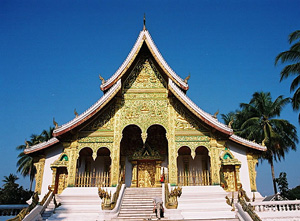 Near the west gate is a 1990s addition: a small pavilion set in a rose garden houses a seated Buddha in the Earth Witness pose. War Xieng Thong has four entrances (at the south or city gate there used to be hitching posts for royal elephants); atop the plain brick east gate are two small guardian lion statues; at the north side, outside the temple, two pairs of large white cat statues guard the steps down to the Mekong River.
Near the west gate is a 1990s addition: a small pavilion set in a rose garden houses a seated Buddha in the Earth Witness pose. War Xieng Thong has four entrances (at the south or city gate there used to be hitching posts for royal elephants); atop the plain brick east gate are two small guardian lion statues; at the north side, outside the temple, two pairs of large white cat statues guard the steps down to the Mekong River.
Wat Mai
Next to the palace is War Mai, a temple inaugurated in the 18th century. It took more than 70 years to build, and was once home to the Supreme Patriarch of Lao Buddhism. The wooden sim is built in classic Luang Prabang style, with a magnificent five-tiered roof and pillars with gold patterns stenciled on black. The dazzling exterior wall bears gold stucco bas-reliefs recounting the legend of Pravet, the last incarnation of the historic Buddha, amid a profusion of village scenes; the top band depicts scenes from the Ramayana.
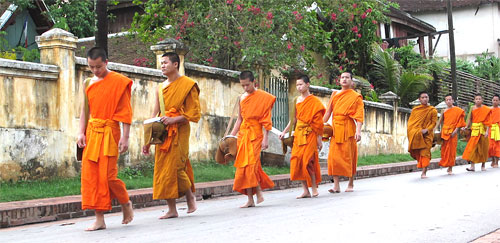 On the grounds of the war are some "elephant pillars": posts painted in red. At Lao New Year, several royal elephants draped in ceremonial blankets were tethered at this site; an ear of each elephant was lifted up and a sermon was whispered into it before the elephants took part in a procession. The ceremony continued until the early 1970s; there used to be elephant hitching posts also at War Xieng Thong and War Visoun.
On the grounds of the war are some "elephant pillars": posts painted in red. At Lao New Year, several royal elephants draped in ceremonial blankets were tethered at this site; an ear of each elephant was lifted up and a sermon was whispered into it before the elephants took part in a procession. The ceremony continued until the early 1970s; there used to be elephant hitching posts also at War Xieng Thong and War Visoun.
Petite Luang Prabang
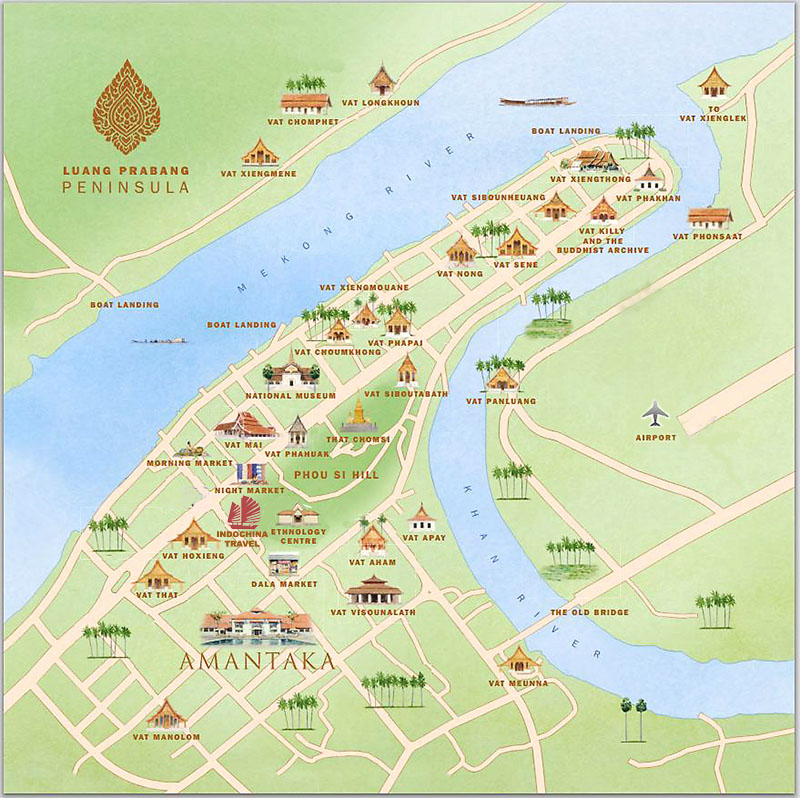
Other Temples
Rising early before sunrise, witness the long lines of orange-robed and barefoot monks meandering on their alms rounds on the main streets and back alleys of Luang Prabang. Locals offer sticky rice as well as other food and necessities to the monks. The long line of monks creates a swirl of orange, accentuated by the soft morning light. Within an hour, the monks complete their rounds and melt back into the monasteries and the streets become quite ordinary again. Although this alms-giving ritual can be seen in numerous parts of Southeast Asia, it's particularly striking in Luang Prabang because of the density of temples on the peninsula and the concentration of monks (there are more than 500 in Luang Prabang). You'll be most welcome at the wats-many of the monks are studying English or French, so it's easy to make friends. If you're in Luang Prabang during a festival, it will most certainly be centered around one or more of the wats.
Of the 40-odd wats around Luang Prabang, the best-preserved and most lavish are those strung along Phothisarat Street, in line with the Palace Museum, from War Mai to Wat Xieng Thong. These wats were formerly associated with royalty; the villas and residences of royal Lao family members were also located along this strip, as were the residences of the French in the colonial days. Villa Santi, now a small hotel, was the residence of a real princess; it was returned to her family in 1991. Down this way is Wat Sene, with a Thai-style sim with a yellow-and-red roof, built in the 18th century with later restorations. A side temple encloses a large standing Buddha and a drum.
Those interested in Lao art, architecture, or Buddhism might want to explore the wats further. Each war has its own character and features. Wat Khili presents an unusual blend of French colonial and Lao temple architecture. Wat Visoun features a sim with a high ceiling, a collection of Buddha statues, and a 35-meter-high Lotus stupas called the "melon stupas" because of its shape. Wat Manorom is noted for its large armless bronze Buddha, reckoned to weigh several tons and reputedly cast in the 14th century.
Hiking Across the River
There are good views of Luang Prabang from the other side of the Mekong, and we can arrange a rambling hike along the foreshores here for two to five hours through villages and derelict, semi-abandoned wats. This side of the river is ideal for hiking because there's hardly any motor transport, even motorcycles dissipate.
Once across the river, we'll explore Wat Xieng Mene, in a village of the same name. The wat has an elaborate gilt door. Two kilometers from the village in the forest is the royal cemetery with sculptures of royal family members who could not be cremated, including victims of contagious diseases, or children who died as infants. It's hard to persuade local guides to visit this place who are terrified of ghosts.
Market and Mekong Touring
Touring by bicycle or motorcycle, tuk-tuk, or with a sidecar-taxi, is a pleasant way to get a glimpse of local activity. Ask us to take you out by bicycle, the distances are not great anywhere in town and we can plan longer excursions as well.
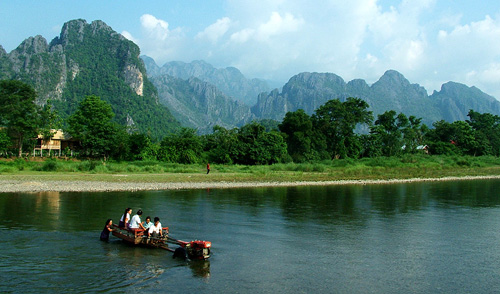
|
For a shorter bike ride, we begin this cycling tour at the foot of Thanon Kitsirat Settathirat, where a flight of stairs leads down to a small-craft loading area. It's very busy here in the early morning, with boats coming in from outlying areas, and boats headed upstream for Muang Ngoy or Ban Huay Sai. From here go southwest to the Kaysone Phomvihane Memorial, with a bust of the revered revolutionary parked at a roadside shrine. This memorial displaced what used to be the biggest market in Luang Prabang, but a new market has been established just to the south. From here you can continue past the stadium to another memorial: War That Luang, where the nation's penultimate king rests. King Sisavang Vong's ashes I are interred inside the large gold stupas at one end of the compound. Locals often come to leave offerings.
Straight ahead along this road is Dara Market, the prime trading center for consumer goods. Hmong women sometimes shop here, wearing long black dresses with blue sashes and a pompom hats. Hmong villages are found about 15-30 kilometers (10-20 miles) outside of Luang Prabang, but they're up in the hills and hard to get to. Silk and cotton sinks are sold here for varying costs depending on design and quality (and you're bargaining acuman). Textiles, embroidery, and bags are on sale too. Silver is sold by weight, though quality craftsmanship is a factor. Luang Prabang is closer to Kunming than Bangkok, and in the markets Thai consumer goods are starting to give way to Chinese goods. You can find Chinese soap, bicycles, Mao caps, thermoses, and American baseball caps made in China. From Dara Market, head southward on Thanon Kitsirat Settathirat and take a right for a detour to Naviengkham Market, where stalls are piled high with produce. Photo opportunities always abound at markets-not inside, since the markets are covered and you need a flash, but outside where huge loads are stacked onto motorcycle sidecars.
Continuing northward, you'll come to a crossroads. From this direction you're treated to a striking view of Mount Phousi, with the gold spire of That Chomsi rising high above. Riding toward Mount Phousi, to the left is War Aham, with two banyan trees in the grounds, an important spirit shrine. A pleasant place to take a breather is Khemkhane Garden Restaurant, overlooking the Khan River. An option here is to leave your bike at the restaurant and head off for a foot tour of Mount Phousi. You can climb a set of stairs near the restaurant, hike to That Chomsi, and return via Tham Phousi and Pra Puttabat to War Paphane, then walk back along the road to the restaurant.
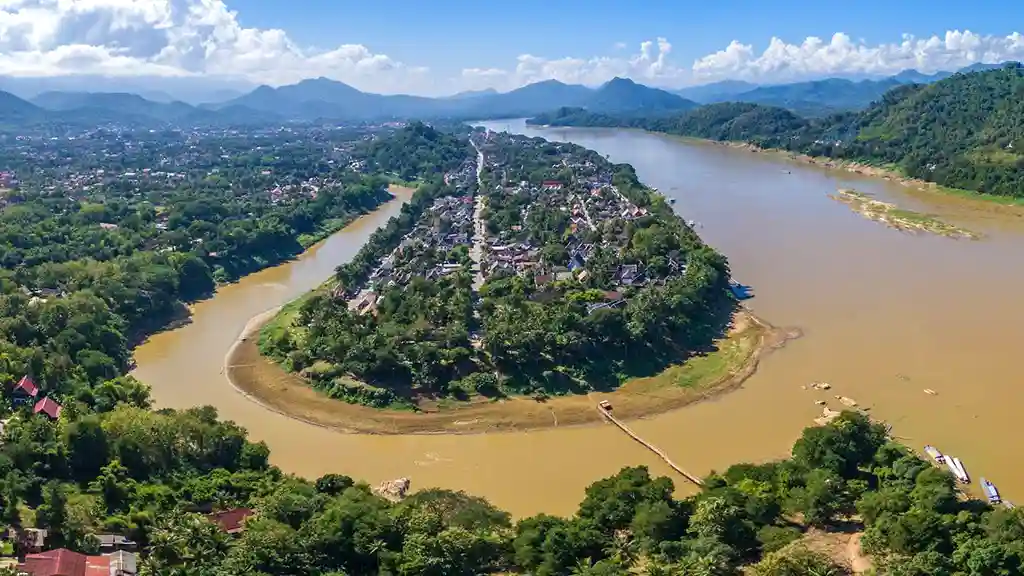
From Khemkhane Restaurant, carry on round to War Pak Khan, also known as the Dutch Pagoda because its wooden doors are carved with costumed figures said to be 18th- and 19th-century Dutch explorers. A short distance from here is War Xieng Thong, the most stunning of Luang Prabang's many wars. Around the corner, along the river, are some excellent open-air places serving drinks and snacks, and sometimes serving up a Mekong sunset as well. For great views there is the dining terrace of the Auberge Calao, or the pleasant atmosphere of Banehous Restaurant.
The destroyed Wat Chom Phet, is also a peaceful spot with expansive views. The walking trail continues to War Long Khoun, which, though small, is the principal active wat on this bank. It has seen a lot of reconstruction, but faded 18th-century grandeur may be detected in the murals, some of which show foreign traders. From this point there's a forest trail to War Tham, an abandoned war in a deep limestone cave, with stairs cut out of stone. You need a flashlight to explore. The cave-temple was a storage depot for statuary from destroyed wats around Luang Prabang, and is stacked with rotting Buddha images. There are several other caves nearby. Wat Tham is almost directly opposite Wat Xieng Thong. If you can find a villager with a boat, you can cross the Mekong here for a small fee, but you'll most likely have to backtrack to the War Long Khoun area to find a boat.
Touring by boat
The royal way to see Luang Prabang is to cruise the river-see the waterfront docks, visit War Xieng Thong, tour the opposite bank of the Mekong, and explore the Khan River. The popular boat ride along the Mekong north to Pak On Grottoes is something we offer an interesting variation of, launching rather from the Nam Ou river by private boat.
The Elephant Village
Just outside Luang Prabang near Xieng Lom village is an elephant sanctuary which founder Markus Peshke created to provide care and an organization to sustain the endangered Asian elephants living at the "village." The Elephant Village ensures the support and the survival of (currently) 9 elephants living in harmony with nature and the community of care givers and handlers from the Xieng Lom village. They are kept away from abusive work and cared by professional veterinarians. We can arrange a private half- or full-day with a charming young elephant in the spectacular setting along the river. Post-camp, the Tad Sae waterfalls are nearby offering a beautiful short hike through the jungle.
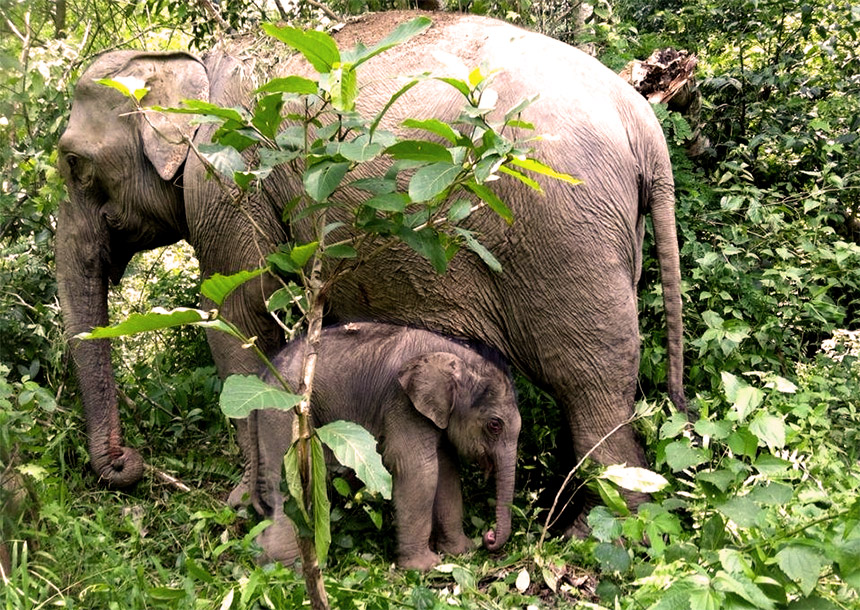
For a more comprehensive elephant experience with historical romance, Markus also founded Shangri Lao, an expedition camp to support conservation efforts of the Elephant Village. The half to two-day expeditions follow in the footsteps of the great explorer Dr. P. Neis along the Nam Khan River, or the ‘Shangri Khot’ camp, following the same route through the Huay Sae Stream as Dr. P. Neis explored 130 years ago.
Accommodations in Luang Prabang
Luang Prabang offers a number of charming, albeit cramped, boutique hotels within the actual town. These smaller properties offer the benefit of walking from your hotel to nearby sights, or some cases, monks pass right in the early morning on their alms rounds.
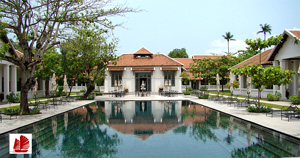 Further outside the central area of town are world-class accommodations, including the newer Amantaka of the renowned Aman chain. The existing single story group of buildings of a former hospital were extensively refurbished to reveal the French colonial architecture. Thousands of custom made jade-colored tiles run throughout the stark and airy complex. Villas are free standing and some villas offer smaller private pools. Lao artwork adorns the walls and there is a boutique for purchasing much that is on display. A library, spa, pool, fitness facility, and Lao and French-influenced cuisine in a number of dining venues round out the resort's offerings. Bikes are available for cruising into town on one of our recommended cycling tours.
Further outside the central area of town are world-class accommodations, including the newer Amantaka of the renowned Aman chain. The existing single story group of buildings of a former hospital were extensively refurbished to reveal the French colonial architecture. Thousands of custom made jade-colored tiles run throughout the stark and airy complex. Villas are free standing and some villas offer smaller private pools. Lao artwork adorns the walls and there is a boutique for purchasing much that is on display. A library, spa, pool, fitness facility, and Lao and French-influenced cuisine in a number of dining venues round out the resort's offerings. Bikes are available for cruising into town on one of our recommended cycling tours.
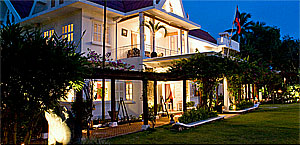 Maison Souvannaphoum, a restored royal residence, is located on the main drag just outside the central town area but within walking distance of all attractions.
An overdue remodeling is taking place in the summer and early fall of 2011 which should restore the Maison's slipping quality over recent years. Dining options (we recommend by the tranquil poolside) include French, Laotian and Indochinese cuisine. The Maison Souvannaphoum features rooms from a colonial era long past, with wood floors and architectural elements and period furniture.
A spa and pool are provided amenities.
Maison Souvannaphoum, a restored royal residence, is located on the main drag just outside the central town area but within walking distance of all attractions.
An overdue remodeling is taking place in the summer and early fall of 2011 which should restore the Maison's slipping quality over recent years. Dining options (we recommend by the tranquil poolside) include French, Laotian and Indochinese cuisine. The Maison Souvannaphoum features rooms from a colonial era long past, with wood floors and architectural elements and period furniture.
A spa and pool are provided amenities.
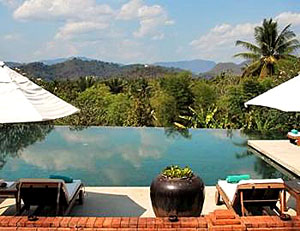 La Residence Phu Vao rounds out the luxury properties in Luang Prabang. A long time favorite, we enjoy the views over town and the quieter mountainside setting just outside the town. Managed by the Orient Express, La Residence Phu Vao is rich with traditional architecture, woodwork surrounds guests from beams, to floors and furniture but the setting is largely open air and there are many areas to relax and enjoy the setting outside the rooms. Phu Vao has a spa, boutique, and pool and offers cooking classes, yoga and other activities. From here, we can also organize cycling up the river to the Kuang Xi waterfalls or pleasant side roads outside of town.
La Residence Phu Vao rounds out the luxury properties in Luang Prabang. A long time favorite, we enjoy the views over town and the quieter mountainside setting just outside the town. Managed by the Orient Express, La Residence Phu Vao is rich with traditional architecture, woodwork surrounds guests from beams, to floors and furniture but the setting is largely open air and there are many areas to relax and enjoy the setting outside the rooms. Phu Vao has a spa, boutique, and pool and offers cooking classes, yoga and other activities. From here, we can also organize cycling up the river to the Kuang Xi waterfalls or pleasant side roads outside of town.
Newer resorts have opened, including the Rosewood, a tranquil retreat in the jungle. Ask us for detailed information on these Luang Prabang hotels for our unbiased feedback as well as those of past clients.
Luang Prabang's Culinary Delights
In Luang Prabang, you're in for a treat: the local food is a distinctive branch of Lao cuisine, with sour and bitter flavors in some dishes. Try ohlam, a category of slow-cooked dishes with simmered dill, vegetables, and meat or fish; and larp, a pounded seasoned paste of fish or meat dish eaten with sticky rice. Luang Prabang offers good tasting sticky rice, plenty of steamed vegetables, a distinctive warm salad of lettuce, herbs, and egg, as well as delicious grilled fish and meat, generally served with one of the many hot-tasting relish-cum-salsas called jaew. You can find much of this in the small night market between the river and the post office, as well as in restaurants a specializing in Luang Prabang food. You'll also find Chinese and French restaurants, somewhat pricey and generally good. Try eating noodle soup from vendors near Talad Data or other markets; you'll also want to taste the small, lettuce wrapped flavor packets sold by street vendors and generically known as miang. For more detailed information, please request our annual restaurant guide.
Market & Street Eats
Like most other destinations in the regaion, some of the most delicious dishes can be found on the street and in markets. Luang Prabang has a number of culinary specialties. Watercress grows around waterfalls and is used in salads; a river moss from the Khan River is mixed with sesame; soups are flavored with spicy or bitter-hot herbs. At market stalls you can find excellent tam som (green papaya salad), ground as you watch; locals also make tamarind jam and pineapple jam, and their own moonshine liquor, lao lao.
Markets feature fresh and tasty Laos food, and good places to hunt for breakfast. Markets are humming from 8:00 AM to 9:00 AM; here you can find French bread and Spam-pate, and sometimes crude croissants. At the south side of Dara Market you can get good soups and French bread, as well as fresh mandarin juice and coffee. Look for small pineapples and finger bananas to supplement your breakfast rations.
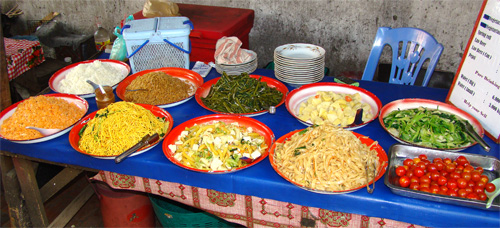 |
Overlooking the Mekong, on the strip between the Palace Museum and War Xieng Thong, are several thatched and wooden structures that serve drinks, snacks and tasty main dishes; here you'll find the Banehous, and Bouasavanh restaurants, which are popular traveler hangouts. There's also cluster of family-run restaurants in the vicinity of the Rama Hotel, Yong Khoune Restaurant and Visoun Restaurant have selections of Chinese and Lao dishes; Luang Prabang Restaurant serves European and Lao. Just east of Phounsab Guesthouseare two good places to eat: Luang Prabang Bakery and Le Saladier, a French restaurant. Another stretch of restaurants is in the vicinity of the Rama Hotel, south of Dara Market. For real atmosphere, Khemkhane Garden Restaurant has thatched cottages perched over the Nam Khan (Khan River), a tributary of the Mekong. Meal, or just have drinks-very pleasant.
Farther north on the Nam Khan is Duang Champa, tel. 212420, a restored mansion-restaurant and bar run by a Frenchman and his Lao wife. Naturally, they serve French and Lao specialties-atmosphere and presentation are superb. Near War Nong is the longtime favorite with atmospheric dining area, L'Elephant Brasserie, with spacious seating and an eclectic menu. Another favorite of our past travelers for authentic Lao food is Villa Santi, with Lao fixed dinners. There may be performances of traditional dance staged here.. On the west side of Luang Prabang is Malee Restaurant, quite few notches down in decor, but no loss at all it the food department. Malee serves a good range of Lao dishes, including spicy eggplant soup, chicken salad with lemongrass, and curried fish dishes.
Shopping
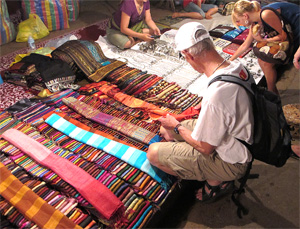
Dara Market features a wide selection of silver items and textiles. Silk and cotton sinhs are available; silver jewelry and other items are sold by weight, and often purchased by Hmong hilltribes as portable wealth. Larger hotels-the Phou Vao, Phousi, and Villa Santi-have higher-priced gift shops.
Strung out along Thanon Phothisarat are a number of souvenir shops. There are a few specialty shops-between Data Market and the Vieng Keo Hotel is a shop that sells high-quality textiles and handicrafts; down by the Mekong, near Villa Santi, is a silversmithing shop with items made on the premises. Opposite War Mai is a woodcarving place.
Banking: Lane Xang Bank is right near Luang Prabang Tourism. Rates are higher for cash than for traveler's checks, and not as good as rates in Vientiane for traveler's checks.
Standout Shops
Ock Pop Tok
Ock Pop Tok is a Laos based social enterprise working primarily in the field of textiles, handicrafts and design. Meaning “east meets west”, Ock Pop Tok brings the fascinating world of traditional Lao handicrafts alive for visitors. Our beautiful Living Crafts Centre overlooking the Mekong is the heart of Ock Pop Tok.
Organizers of the Living Crafts Center, set in lush tropical gardens and located on the banks of the Mekong, the perfect place to learn more about the fascinating world of Lao textiles and handicrafts. Guided tours are offered where you can marvel at the skills of our silk weavers and craft artisans and even meet our silkworms. After strolling around our gardens where we grow the plants for our natural dyes and seeing vivid hand-dyed silk drying in the sun, you never look at a scarf in the same way again. Ban Saylon (opposite Phousi Market) Luang Prabang, Lao PDR +856 (0)71 212 597 Web: http://ockpoptok.com/.
Caruso Lao
Products are designed and crafted in Laos. Our silks are handwoven by local weavers. Our exclusive woods are indigenous to Laos and handcrafted by master carvers and turners. These unique products can be seen at our showroom in Vientiane, located in a charming colonial house overlooking the Mekong River. You will also find us in Luang Prabang, at our shop and gallery on Sakarine Road opposite the Primary School. Web: www.carusolao.com
Login to our client site for current recommendations for other shops, galleries, and markets.
Getting Around
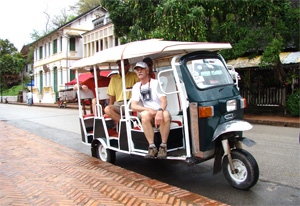
One of Asia's rarer walkable cities is pleasant by foot, but also by bicycle, motorcycle, sidecar-taxi, or tuk-tuk (right). Some hotels rent cars. Luang Prabang is small and flat, so a bicycle can easily cover the ground; bicycles are pleasant in the small town Motorcycles with sidecars are a common way of getting around Luang Prabang.
Excursions from Luang Prabang
Hiking Luang Prabang
A couple hours from Luang Prabang, our hiking trips take you into another world, away from anything that exists in most of Southeast Asia—dense cloud forest far, far away from any other travelers. These logging trails are only accessible by boat, distant from from any town. High up here in the Annamite Mountains, spires of rocky outcrops are clothed in dense tropical vegetation. The landscape, as far as the eye can see, is made up of forest and spectacular limestone cliffs that rise up like jagged teeth above the ridges. A handful of hilltribe villages down river cling to the dusty red slopes of the mountainside, their plumes of smoke tapering off into the distance. Nothing else moves on this wild and glorious terrain. We can organize hiking for all abilities, from a couple of hours to several days.
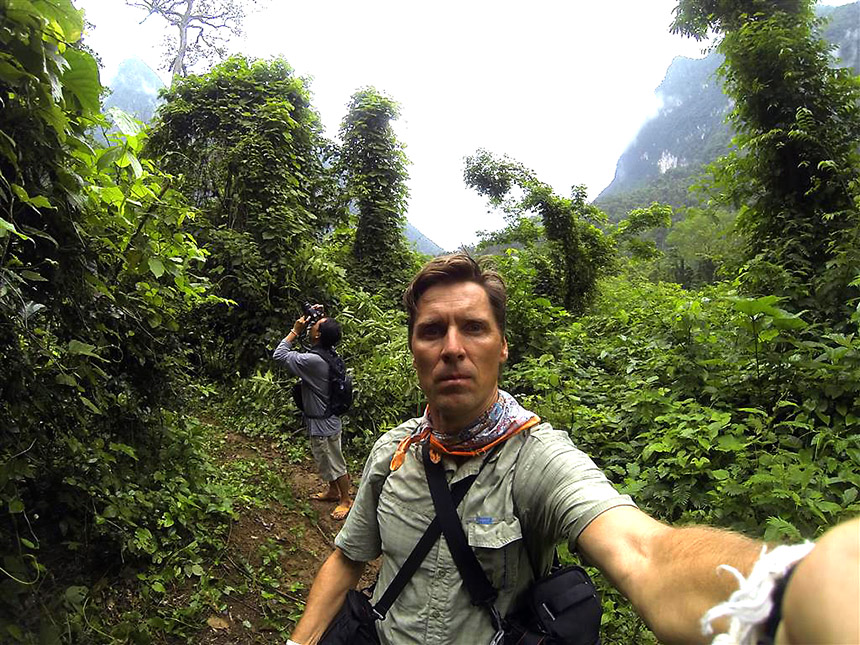
Pak Ou Grottoes
A comoon day trip from Luang Prabang, closer in, is a half or full-day's excursion by boat along the Mekong to the Pak Ou Grottoes at the confluence of the Nam Ou River, about 25 kilometers upstream from Luang Prabang. On the way you can stop in the village of Ban Sang Hae, where moonshine whiskey is made. Just as interesting as the destination is the trip along the Mekong; the river runs wide, cutting a swath through jungle-clad banks and limestone gorges. There are times, on a slow boat headed down the river, when you are completely alone with not even a village in sight.
About 20 kilometers-or 90 minutes-out of Luang Prabang along the Mekong is Ban Sang Hae, a village engaged in the production of rice whiskey. In the rainy season, the villagers grow glutinous rice, which is fermented in water and yeast in the dry season-a process that takes 10 to 15 days for each batch. This under-the-table whiskey, or lao lao, sells cheaply by the liter or bottle in Luang Prabang. This firewater is best drunk over ice, with a dash of lime and soda, or Coke if you prefer.
Pak Ou Grottoes are sacred caves tucked into limestone cliffs and filled with hundreds of gilded and wooden Buddha statues. Many of the images are in the distinctive Lao stance of Calling for Rain. Cave temples have been of religious significance throughout Asia from the earliest days of Buddhism, creating unique places for Buddhist monks and hermits to dwell and worship; the Pak Ou Grottoes were once occupied. Now candles and filtered light illuminate the caves, pervading them with an aura of holiness. The lower cave, Tham Ting, is reached by a series of steps from the Mekong. From here, you climb to the upper cave, Tham Phum, which is deeper and darker and requires a flashlight to explore. There are picnic shelters for lunch between the lower and upper caves. The caves are thought to he the home of guardian spirits, and the site was once inhabited by monks. The king of Laos used to visit here once a year; today, at Lao New Year, hundreds of pilgrims wend their way out from Luang Prabang.
"Pak On" means mouth of the Ou River. After stopping at the grottoes, you can detour up the Nam Ou tributary-a great ride, as the banks here are much closer than on the Mekong. This route is used by small craft heading to Phong Saly province.
Longer River Trips
The most spectacular section of the Mekong in Laos is the upper section, westward from Luang Prabang. Routing ideas include taking a slow boat or longtail speedboat from Luang Prabang to Pakbeng and on to Ban Huay Sai, or following the reverse route. From Ban Huay Sai, one may fly to Vientiane or cross over to Thailand.
A great river route we highly recommend is from Luang Prabang up the Nam On tributary to Muang Ngoy, then overland via Muang Sai to Pakbeng, where you join the Mekong again. From Pakbeng we can return along the Mekong to Luang Prabang, or forge westward to Ban Huay Sai. River conditions must be favorable for the trip up the Nam On (a nonstarter in the dry season); the round-trip circuit from Luang Prabang takes two to four days, with overnights possible in Muang Ngoy, Muang Sai, and Pakbeng. The land portions of this trip are fine, but on both rivers the scenery is spectacular.
Santi Chedi
About three kilometers east of Luang Prabang is a forest war, Pra Phon Phao, famed as the abode of meditation master Saisamut, who died in 1992. The gold-spired Santi Chedi, or Peace Pagoda, was constructed in the 1970s and 1980s and completed in 1988. The octagonal yellow stupas has three floors and a view terrace at the top. The exterior features beautifully carved wooden shutters and doors; inside, on the ground floor, are hellish comic-strip frescoes showing the fate awaiting adulterers, murderers, and thieves-scenes that appear to spring straight out of Dante's Inferno. (In the Buddhist system of reincarnation, there are half a dozen realms for rebirth, among them the realm of the Hungry Ghosts and the realm of the Hells. Because Buddhism predates Christianity, Christian representations of Hell may well have been copied from Buddhist versions.)
The upper floors contain frescoes with peaceful episodes from the life of Buddha. Make your way through to the top cupola for views of Luang Prabang. Sand Chedi is open daily 0800-1000 and 1300-1630. You can bicycle out there or take a sidecar-taxi. A little way out of Luang Prabang to the southeast you come to a fork in the road; the left fork goes to Sand Chedi, the right _ fork to Ban Phanom.
Luang Prabang with Kids
Luang Prabang provides some of the best options for family travel in the region, from boating, biking, light trekking, to elephant camps (right), where we can arrange a private encounter to learn the care and feeding of rare Asian Elephants. We can organize educational activities, such as visiting a silkworm farm to learn how silk is produced. Hands-on cooking classes are also a popular activity. Biking to Kuangsi waterfalls is a perfect family trip for those with older children, culminating in a cool dip in the waters.
In the past, we have also arranged private encounters with monks in their temples to learn about their lifestyles and beliefs and private baci ceremonies, a lao welcoming tradition in the home of local family. Our family trips can be organized for children of all ages, including separate time for parents to enjoy a romantic dinner by themselves.
Village Visits
You can combine visits to scenic sites with village visits en route. A pleasant picnic and waterfall spot around town is Kuangsi Falls, 30 kilometers to the south of town. The impressive falls are multitiered and accessed by forest trails-you can hike right to the top of the falls. In a nearby village are water-driven rice mills, and about 10 kilometers short of the falls are several villages engaged in the spinning of raw cotton. Another waterfall destination is the pristine Tad Se Falls, about 15 kilometers southeast of Luang Prabang.
Closer to town, the villages of higher interest are those specializing in a particular craft. Ban Phanom, three kilometers southeast of town is an ancient weaving village-people working handlooms under the houses turn out cotton and silk shawls and sinhs. However, visitors are led to the village tourist trap, a circular area where the village women practically leap into the air with hard-sell tactics. Ask your guide for other options, further out.
Four kilometers west of Luang Prabang is the village of Ban Chan, which produces ceramic storage jars and pots. The village can be reached by boat along the Mekong, or by road and a short boat hop. Right near the airport is the village of Hat Hien, whose inhabitants use simple implements to make knives and metalware. Take a dirt track just before reaching the main terminal building; the village is 500 meters down this road. This is not a quiet place. The air is filled with the din of sledgehammers striking metal, supplemented by the odd plane overhead and intense heat from bellows-operated foundries.
Beyond Luang Prabang : Exploring Laos
Beyond Vientiane, Vang Vieng, and Luang Prabang, Laos remains little traveled. It offers a handful of archaeological riddles-the mysterious Plain of Jars, and the abandoned temples of War Phu-and high ethnic interest with numerous hilltribe groups in the northern mountain valleys and the plateaus to the east in picturesque landscapes. Then there are natural wonders-the mystique of the Mekong, from its majestic passage through northern Laos to its foaming and frothing departure at Khone Falls near the Cambodian border. Laos is opening up, but it's a slow process.
Bicycle Laos—Biking The Laotian Alps
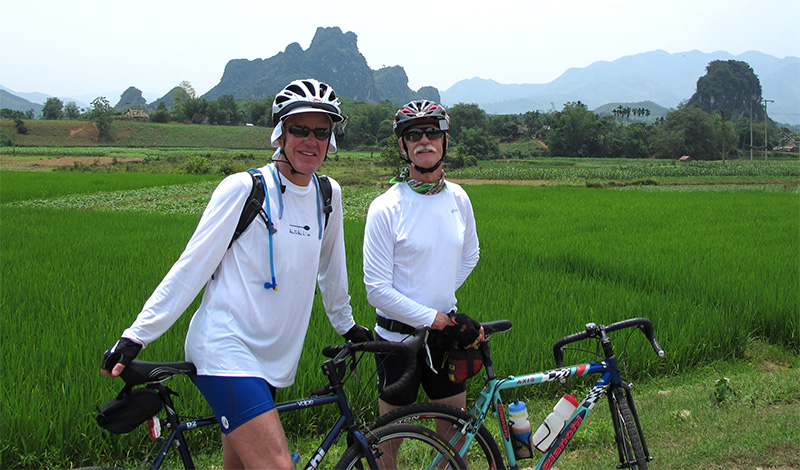
Enjoy one of the last overland, point-to-point bike tours from the Vietnamese capital, Hanoi, to Luang Prabang over several days traveling through newly-acessible, rural areas of the country, including high mountains above 1,500 meters and through a couple of picturesque national parks. Accommodations are basic, but the reward is a glimpse of a rapidly-disappearing traditional agrarian culture. We also offer adventurous cycling trips along this route through our adventure wing, VeloAsia. Our biking tour from Hanoi to Luang Prabang offers quiet roads and magnificent scenery. If you're looking for a unique tour in the region this new trip is that. Click to read more about our Laos cycling tour.
